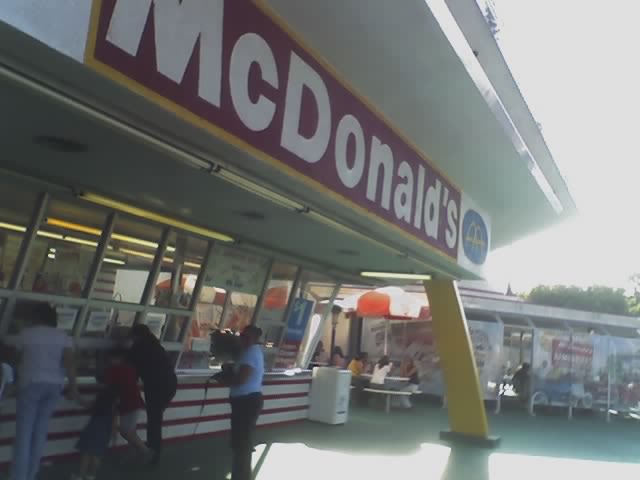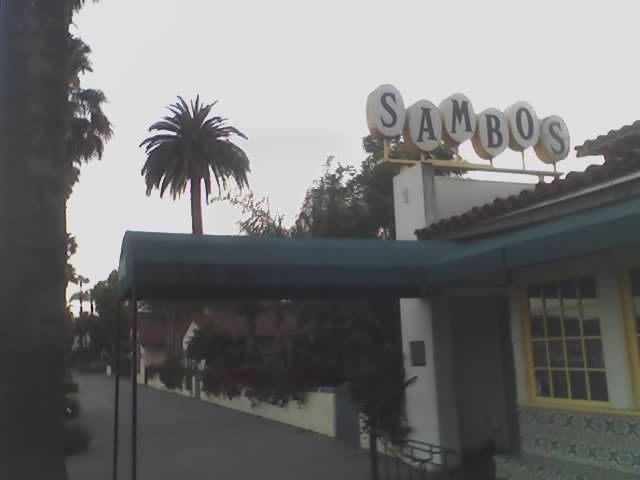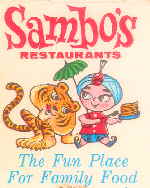 Speedee has never heard of anyone named Ronald. But he knows about
golden arches. They're built right into the building below him!
Far below him...
Speedee has never heard of anyone named Ronald. But he knows about
golden arches. They're built right into the building below him!
Far below him...
Look! It's the famous red McDonalds wagon! Dishing out burgers, old-school style!
That comparatively tiny truck gives you some idea of just how high off the ground Speedee really is!
 Walk right on past those golden arches - and they'll
hand you a burger from this adorable take-out window!
Then you'll drive off and eat it somewhere else.
It's 1953! You're an on-the-go Los Angeleno! You don't have
time to sit around eating in a McDonalds!
Walk right on past those golden arches - and they'll
hand you a burger from this adorable take-out window!
Then you'll drive off and eat it somewhere else.
It's 1953! You're an on-the-go Los Angeleno! You don't have
time to sit around eating in a McDonalds!
Mmm - delicious fast food.But why just burgers? Why not other foods?
Three miles away, on Firestone Boulevard... It's 1962, and you've seen the future of restaurant food delivery. Your brain reels with feverish fast food dreams. What if you did the same thing, but with other foods?
Why not tacos?
The first Taco Bell opened in Downey, in 1962.

Fast-forward to the future. 2005. 43 years have passed, and restaurants and dreamers have come and gone.Oblivious, a young entrepeneur wanders to 7112 Firestone Boulevard. They see something special in its brick and neon. All it needs is a fresh coat of orange paint, delicious meals, and hope.
It's a Los Angeles miracle. Wait around long enough, and everything old becomes new again. They looked at this building and decided to open........
A taco restaurant.

Now if you're under the age of 30, you probably don't remember Sambos restaurant - but there were 1200 of 'em across America. And the very first one staked its homestead not far away, on a picturesque beach in Southern California.

A mere 100 miles away, in Santa Barbara, another dream was glimmering in the eyes of Sam Battistone and Newell Bohnett. In1962 they combined their names -- Sam and Bo[hnett] -- and created this new family-oriented restaurant experience.

Their delicious pancakes made them famous - although due to an unfortunate marketing decision, they'd plastered their walls with the story of "Little Black Sambo" - a clever Indian boy who turns a pack of hungry tigers into butter for his pancakes - just as America was becoming sensitive to centuries of racial discrimination.In their last days, the restaurant switched to various white mascots, and changed their name to "No Place Like Sam's." But by 1981, they were bankrupt.
But in 2005, back where it all began, one restaurant remains. And 40 years later, a circle closes.
"We had dined at this Sambos in 1965 and then moved to Santa Maria CA...[T]oday we were visiting in Santa Barbara and we drove by Sambos and my wife and sister-in-law said we should stop for lunch. Boy am I glad we did.
The food was exellent and a young man (our server) named Alex was delightful as well as accommodating... Thank you Sambos and thank you Alex.
Maybe that's how this story should end - humungous nationwide franchises magically transformed back into local restaurants.
And in 2020, that final Sambo's restaurant relinquished its name, promising it would come up with a new name. While in the meantime, reported CNN, "The restaurant's sign has been covered, at least temporarily, with a peace sign, an ampersand, and the word 'love' for Peace and Love."But there's another story that's also about responding to the community. As a kind of epilogue, years ago McDonalds had tried to tear down their old Speedee sign. There were other licensed franchises in Downey - more slick and more modern - and McDonalds no longer wanted a clunky neon mascot from 1953.But then a funny thing happened. An unusual cry came up from the people of Downey themselves. They didn't want to lose it - their moment of history, their sign, their famous restaurant.
Some cried cover-up - pointing out that Ray Kroc had bought out the original McDonald brothers in 1961, and theorizing that McDonalds' new corporate identity demanded that they snuff out any previous incarnations. Others argued its cultural significance. The sign shines with history, and they wanted to preserve it.
The people of Downey had decided. They'd looked inside their hearts, and had chosen to make their voices heard. Please, Mr. Corporation Man. Please. Don't take away our Speedee.
McDonalds agreed.Speedee shines on...
And the next 50 years begins.
See also:
The man who photographed every Sizzler in America
A review and history of Knott's Berry Farm
Save the Portland site of the first Denny's in America!
 It's 1953 in Downey, California.
It's 1953 in Downey, California.

